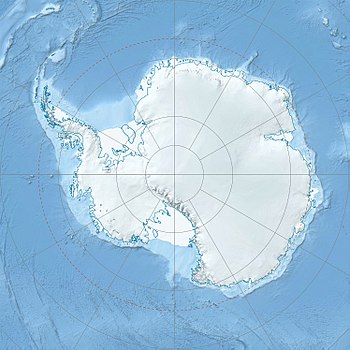Amundsen–Scott South Pole Station
| Amundsen–Scott Station | |
|---|---|
| Antarctic base | |
| Amundsen–Scott South Pole Station | |

A view of the Amundsen–Scott Station in 2009. In the foreground is Destination Alpha, one of the two main entrances.
|
|
 A map of Antarctica showing the location of the Amundsen–Scott South Pole Station (circled) |
|
| Location of Amundsen–Scott Station at the South Pole in Antarctica | |
| Coordinates: 90°S 00°E / 90°S 0°ECoordinates: 90°S 00°E / 90°S 0°E | |
| Country |
|
| Location in Antarctica | Geographic South Pole, Antarctic Plateau |
| Administered by | United States Antarctic Program by the National Science Foundation |
| Established | November 1956 |
| Named for | Roald Amundsen and Robert F. Scott |
| Elevation | 2,835 m (9,301 ft) |
| Population | |
| • Total |
|
| Time zone | NZST (UTC+12) |
| • Summer (DST) | NZDT (UTC+13) |
| Type | All year-round |
| Period | Annual |
| Status | Operational |
| Facilities | Facilities include:
|
| Website | www |
The Amundsen–Scott South Pole Station is a United States scientific research station at the South Pole, the southernmost place on the Earth. The station is located on the high plateau of Antarctica at an elevation of 2,835 metres (9,301 feet) above sea level and is administered by the Division of Polar Programs within the National Science Foundation under the United States Antarctic Program.
The original Amundsen–Scott Station was built by the United States government during November 1956, as a part of its commitment to the scientific goals of the International Geophysical Year (IGY), an international effort lasting from January 1957 through June 1958, to study, among other things, the geophysics of the polar regions.
Before November 1956, there was no permanent human structure at the South Pole, and very little human presence in the interior of Antarctica at all. The few scientific stations in Antarctica were located on and near its seacoast. The station has been continuously occupied since it was built. The Amundsen–Scott Station has been rebuilt, demolished, expanded, and upgraded several times since 1956.
Since the Amundsen–Scott Station is located at the South Pole, it is at the only place on the land surface of the Earth where the sun is continuously up for six months and then continuously down for six months. (The only other such place is at the North Pole, on the sea ice in the middle of the Arctic Ocean.) Thus, during each year, this station experiences one extremely long "day" and one extremely long "night". During the six-month "day", the angle of elevation of the Sun above the horizon varies continuously. The sun rises on the September equinox, reaches its maximum angle above the horizon on the summer solstice in the Southern Hemisphere, around December 20, and sets on the March equinox.
...
Wikipedia

